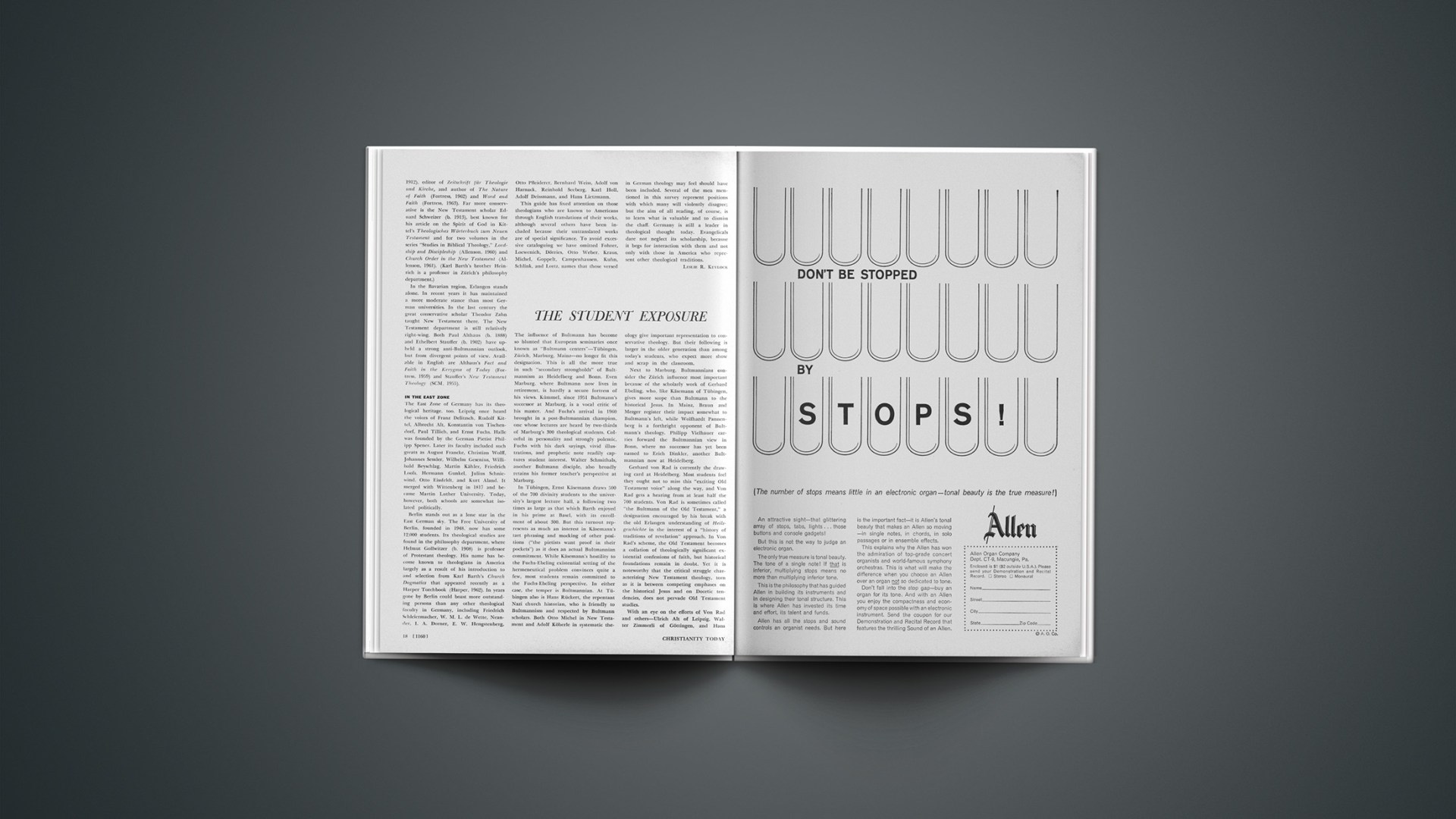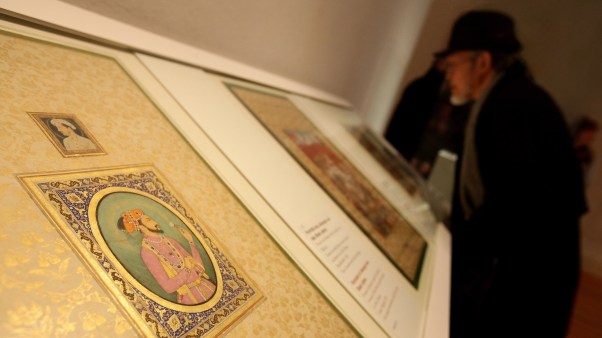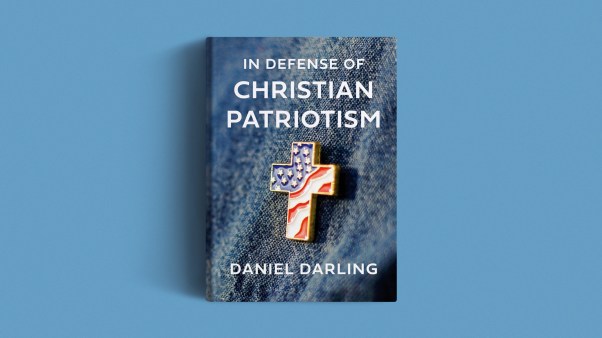The influence of Bultmann has become so blunted that European seminaries once known as “Bultmann centers”—Tübingen, Zürich, Marburg, Mainz—no longer fit this designation. This is all the more true in such “secondary strongholds” of Bultmannism as Heidelberg and Bonn. Even Marburg, where Bultmann now lives in retirement, is hardly a secure fortress of his views. Kümmel, since 1951 Bultmann’s successor at Marburg, is a vocal critic of his master. And Fuchs’s arrival in 1960 brought in a post-Bultmannian champion, one whose lectures are heard by two-thirds of Marburg’s 300 theological students. Colorful in personality and strongly polemic, Fuchs with his dark sayings, vivid illustrations, and prophetic note readily captures student interest. Walter Schmithals, another Bultmann disciple, also broadly retains his former teacher’s perspective at Marburg.
In Tübingen, Ernst Käsemann draws 500 of the 700 divinity students to the university’s largest lecture hall, a following two times as large as that which Barth enjoyed in his prime at Basel, with its enrollment of about 300. But this turnout represents as much an interest in Käsemann’s tart phrasing and mocking of other positions (“the pietists want proof in their pockets”) as it does an actual Bultmannian commitment. While Käsemann’s hostility to the Fuchs-Ebeling existential setting of the hermeneutical problem convinces quite a few, most students remain committed to the Fuchs-Ebeling perspective. In either case, the temper is Bultmannian. At Tübingen also is Hans Rückert, the repentant Nazi church historian, who is friendly to Bultmannism and respected by Bultmann scholars. Both Otto Michel in New Testament and Adolf Köberle in systematic theology give important representation to conservative theology. But their following is larger in the older generation than among today’s students, who expect more show and scrap in the classroom.
Next to Marburg, Bultmannians consider the Zürich influence most important because of the scholarly work of Gerhard Ebeling, who, like Käsemann of Tübingen, gives more scope than Bultmann to the historical Jesus. In Mainz, Braun and Mezger register their impact somewhat to Bultmann’s left, while Wolfhardt Pannenberg is a forthright opponent of Bultmann’s theology. Philipp Vielhauer carries forward the Bultmannian view in Bonn, where no successor has yet been named to Erich Dinkler, another Bultmannian now at Heidelberg.
Gerhard von Rad is currently the drawing card at Heidelberg. Most students feel they ought not to miss this “exciting Old Testament voice” along the way, and Von Rad gets a hearing from at least half the 700 students. Von Rad is sometimes called “the Bultmann of the Old Testament,” a designation encouraged by his break with the old Erlangen understanding of Heilsgeschichte in the interest of a “history of traditions of revelation” approach. In Von Rad’s scheme, the Old Testament becomes a collation of theologically significant existential confessions of faith, but historical foundations remain in doubt. Yet it is noteworthy that the critical struggle characterizing New Testament theology, torn as it is between competing emphases on the historical Jesus and on Docetic tendencies, does not pervade Old Testament studies.
With an eye on the efforts of Von Rad and others—Ulrich Alt of Leipzig, Walter Zimmerli of Göttingen, and Hans Kraus of Hamburg—the Göttingen theologian, Otto Weber, observes: “All the things that New Testament theology could also have rediscovered (history, the covenant, the event of the Word) have been found in Old Testament theology.” Although no single theological influence predominates at Heidelberg, Bultmannian theology has become influential through the presence of Erich Dinkler and Günther Bornkamm, who retain Bultmann’s methodological premises yet deviate to stress knowledge of the historical Jesus. Karl Kuhn likewise has Bultmannian sympathies, but as a Qumran specialist he thinks Bultmann exaggerates the supposed Gnostic influence on the New Testament. Thus he stresses the late Jewish background more along the line of Jeremias of Göttingen. But other Heidelberg scholars are also well received. Both Peter Brunner and Edmund Schlink have long exerted strong influence for the Barthian stream of dialectical theology, although their interest is shifting increasingly in the direction of ecumenical theology.
The mood in Erlangen, where there are 320 students, has much less in common with Bultmann than with Barth and Brunner. Its dominant interest in Brunner probably comes from Paul Althaus’s emphasis on general revelation and on law as distinct from Gospel.
Göttingen has never been dominated by the influence of Bultmann. Of the 300 students, Hans Conzelmann and Joachim Jeremias each draw about 200 to their lectures, where Conzelmann promotes the Bultmannian line but Jeremias rejects it. Reformed theologian Otto Weber outdraws all his colleagues, however; he is not only an able teacher but also a fluent and vigorous lecturer. Through Weber’s influence, and now also through that of his colleague in Lutheran theology, Ernest Wolf, Barth’s position has long been the dominant force at Göttingen and perhaps still is.
At Hamburg, Thielicke’s teaching ability and public popularity attract the largest following from the 300 students. Leonhard Goppelt is appreciated for his historical overview within a broadly conservative framework, although students do not find in him a definitive point of view. Thielicke, Goppelt, and Hans Rudolf Müller-Schweffe are all aggressively anti-Bultmannian, and Thielicke is a firm critic of Barth as well. Bultmann has gained a measure of student influence through biblical studies that support his systematic theology; Barth’s dogmatic writings, on the other hand, are bypassed by most students because of their discouraging length.
The Netherlands and Switzerland, particularly Basel, are broadly conservative exceptions to the dominant pattern of European theology. Basel has never shown great enthusiasm for Bultmann because of Barth’s opposition and that of Oscar Cullman. Both men have recognized the enmity between demythology and the Gospel. Although Barth’s retirement has made Basel a less exciting center for American students, his spirited off-campus student colloquia there still preserve some of his vigorous influence. Except for Cullman’s contribution, the school has little atmosphere of theological controversy. But this is doubtless due in part to a professorial tendency to read lectures prepared for forthcoming books rather than for classroom use.
Swedish theology, more than that of other Scandinavian countries, has moved largely outside the orbit of Continental debate. Denmark, on the other hand, has been most actively engaged. Neither at Uppsala, with 700 students, nor at Lund, with 420, is there much concern with normative theology of any kind. At Lund, Anders Nygren and Gustaf Aulén brought systematic theology to prominence; it has been New Testament exegesis, however, that has traditionally exerted a stronger influence at Uppsala. Since philosophical existentialism is foreign to both Norway and Sweden, any translation of biblical theology into existential categories would only have made Christianity even less intelligible to the “modern man” in those lands. Hence Bultmannian influence, as through his former student, Nils Ahstrup Dahl, New Testament professor of the State Faculty of the Church of Norway, carries little existential significance beyond the broad emphasis on contemporary relevance. Yet Dahl denies that divine revelation is objectively given in history and is thus knowable by historical critical investigation. Reider Hauge, the State Faculty theologian, is a former student of Barth. Despite large indebtedness to his teacher, Hauge questions Barth’s universalistic tendencies, shares Brunner’s commitment to general revelation, and emphasizes the person of Christ as the center of revelation more than objective propositions and subjective decision.
Theological debate in Norway, however, has revolved much more around the classic modernist-conservative themes than around a dispute over dialectical-existential theology. It was a protest against Ritschlian emphases within the State Faculty of Theology that in 1907 led to a faculty division and brought about establishment of a Free Faculty in the Church of Norway. Whereas the State Faculty has enviable facilities, the Free Faculty has 350 students, more than four times the number enrolled under the State Faculty. More open ecumenically, the State Faculty is also less confessionalistic and theologically more diverse. The Free Faculty is more confessionalistic, unreservedly rejects the dialectical theology, and insists on the full inspiration of Scripture. At the same time, the Free Faculty is not totally committed to the orthodox Protestant view of the Bible. Its theologian, Leiv Aalen, contends that inspiration bears only on the Bible’s function of “speaking of creation and salvation in Christ,” and this, he insists, the Bible does everywhere, either directly or indirectly. Aalen considers Genesis a figurative and symbolic representation not to be literally interpreted, and admits elements of “an ancient world view” into the larger scriptural testimony.
In Denmark, where the early Barth of the Römerbrief exerted considerable influence forty years ago, that influence soon attached itself also to Gogarten and finally to Bultmann, to whom a small circle still responds. But independently of his European interpreters, it was Sören Kierkegaard who most directly influenced the Danish scene. That other nineteenth-century Danish opponent of Hegelianism, N. F. S. Grundtvig, also left an enduring impression. In Copenhagen, where there are 280 divinity students, N. H. Söe is broadly sympathetic to the later Barth. Barth’s influence, thinks Söe, will in the long run outrank that of Bultmann.










